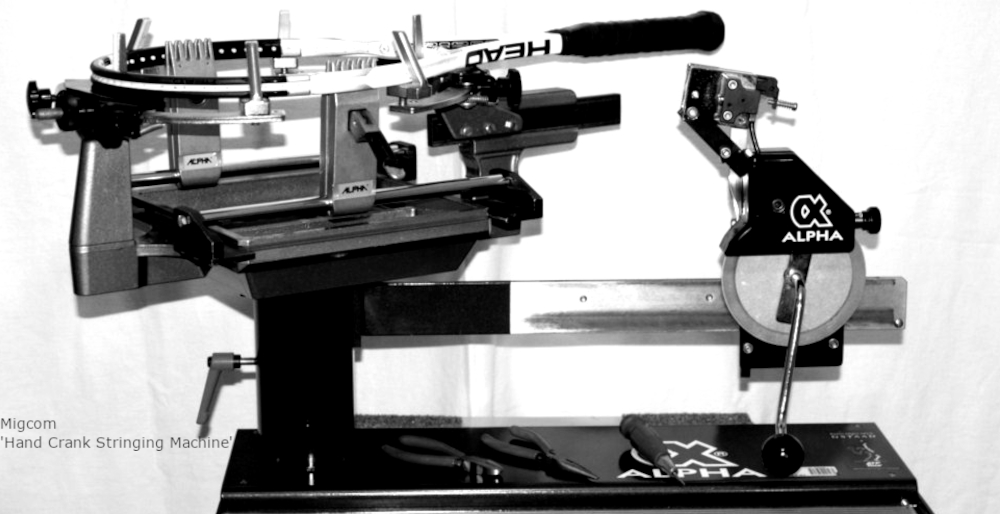String tension is what separates tennis racquets from fishing nets, giving players control, power or a mix between the two. Crank it up too high, and it’ll feel like you’re attacking the ball with a plank of wood…string too loosely and you’ll be the unfortunate owner of a glorified trampoline that will spray balls everywhere but in the court.
Look carefully on your racquet, and you’ll see a recommended tension range – you don’t have to stay within this range, but if you stray, you’d better have a cunning plan in mind. Suggested stringing guides are racquet specific, and the people in white coats have spent many hours testing to see what complements a particular frame. You could string an ultra-powerful racquet very tightly, or put thin loose strings in a low power racquet, but in both cases you’re fighting the underlying nature of the racquet.
| Lower Tension | Higher Tension |
| Power | Control |
| Comfort | |
| Spin** | Spin** |
| Durability** | Durability** |
Power
Low tension strings are able to deflect more on impact. This stores more energy, releasing it back to the ball as it starts to move away from the string bed. More energy released makes the ball travel faster. Think of jumping on a trampoline compared to jumping on concrete. The net result is only in the order of a few percent, but you can feel it.
Comfort
If you suffer tennis elbow or wrist issues, then beware of high tensions – they will transmit a sharp vibration spike and twisting force that will cause problems. Lower tensions, along with softer strings like gut, or a thinner gauge of string, are your friends.
Spin…… and some physics
The eagle eyed reader will have noticed that ‘spin’ appears on both sides of the table. Traditionally it was considered to be enhanced by a lower tension, but research from The University of Sheffield suggests that the situation is more complicated – with very little correlation between tension and spin potential. Lateral string movement, or snap back, is usually thought of as a significant contributor to spin, but high speed camera work suggests this is not so. Instead, an increase in tension reduces power, causing the ball to land short. Players can hit harder to compensate, which generates more spin. Spin therefore is an indirect feature of tension increase.
Control….and some more physics
Lateral string movement, especially evident with heavy topspin shots, is increased with low tensions. As mentioned above, this movement has very little affect on spin, but it does affect control. The ball will initially contact one spot on the string-bed, and then move across the string-bed as the strings deflect. This movement affects where the ball leaves the racquet, which in turn changes the angle the ball flies off the strings. This deflection is inconsistent, and can also lead to twisting of the racquet. Put simply, low tension increases string deflection, leading to inconsistent shots. This is amplified if you don’t hit the ball in the center of the racquet.
Durability
There are several theories about the relationship between tension and durability: one camp contends tight strings have more string on string friction that leads to wear, the other argues they move less, which more than makes up for that. In truth, durability is not a good argument for a particular tension. If you break strings, look at changing string gauge or material.
Tennis is personal
The secret to gear set up is to match your toys with your game – there is no ‘correct’ set up: even pros cover the tension spectrum, from Pete Sampras and his ludicrously tight gut setup down to the low 40lb range for some players using poly strings. If you hit the ball with power, then you can increase tension to give more control, conversely a lower power stroke could benefit from a lower tension. Powerful strings like natural gut often need to be tamed slightly with a higher tension, while lower power stiff strings like poly can take a lower tension without becoming uncontrollable.
All strings lose tension with use, so if you notice your racquet isn’t behaving in the way you’d like, get it restrung. What tension should you begin your voyage of discovery with? Start with the middle of your racquet’s recommended tension range, and adjust according to the following table. An increase or decrease by 2lbs per relevant factor would be a reasonable adjustment.
| more control | increase |
| more power | decrease |
| tennis elbow | decrease |
| stiff string (poly) | decrease |
| powerful string (natural gut) | increase |
There’s a feeling in the stringing world that you should use the lowest tension that gives you the control you need, and this mirrors professional players who, with notable exceptions, have reduced their tensions in recent years – often as a result of a switch to stiffer poly strings. However, beware that very low tension strings can be unduly sensitive to off-center ball strikes.
A Final Thought
If your game is advanced enough for you to really feel the difference in tensions at play, you might be ready to use tension as a way to adjust for different temperatures and court types. Cold weather weather tennis can benefit from loosening the strings by a couple of pounds, slow clay courts can make a slight increase in pace a real advantage and a fast indoor court may benefit from an increase in control. All this points to the importance of experimenting a little – if you have several racquets, try stringing a couple at different tensions….but make sure they are strung at the same time, or they could end up with vastly different tensions as the strings stretch with play.

